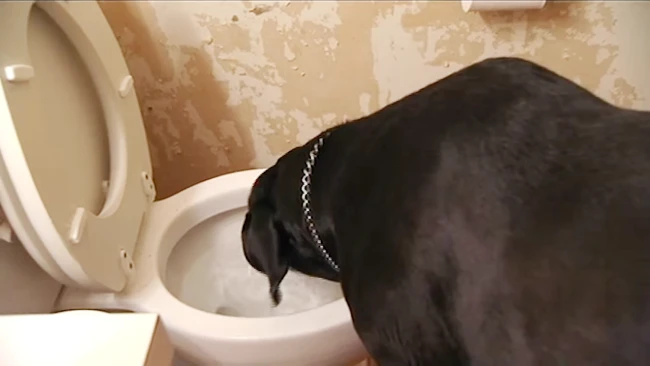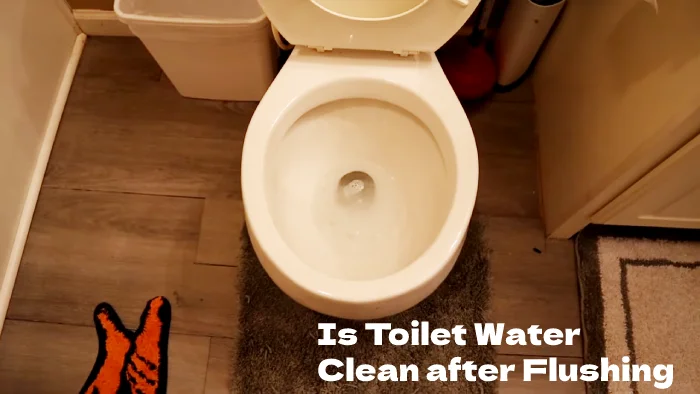Last Updated on October 18, 2023
Toilets are undoubtedly essential to our daily hygiene routines, providing us with necessary sanitation and convenience. Still, the question of whether toilet water is clean after flushing has been perplexing people for centuries.
While it is true that toilet water appears to be clean after flushing, it is not entirely free from germs, bacteria, and viruses. A single flush can release up to 80,000 bacteria and viruses into the air and onto surrounding surfaces.
Despite concerns about bacteria accumulation, scientific research suggests that toilets can effectively reduce bacteria levels during flushing. In fact, due to the continuous flushing process, any dirt or bacteria is quickly removed from the bowl, leaving behind sparkling clean water.
We present you with this informative piece designed to illuminate various aspects of toilet water hygiene. Continue reading to know more.
Why is Toilet Water Clean After Flushing?

Toilet water is clean after flushing due to the mechanics of the flushing process itself. When the toilet handle is pressed, the valve at the bottom of the bowl is opened. It allows the water and waste to be quickly and forcefully pushed into the drainpipe.
This powerful momentum effectively washes away any debris, bacteria, or pathogens that may have been present in the bowl.
Also, the water in the toilet tank is typically clean and fresh, which is the source of the flushing water. This water is supplied by the same source as the water from your faucet.
It is also treated to remove harmful contaminants and bacteria before being sent to your home. The toilet tank is usually made of non-porous material such as ceramic, which prevents the growth of bacteria and other harmful microorganisms.
While the water may be clean, the bowl and surrounding areas may still harbor harmful bacteria and germs. It is recommended to regularly clean and disinfect toilet surfaces to minimize the risk of germ transmission.
What’s the shelf life of toilet water bacteria?
The survival time of bacteria in toilet water varies, depending on the type of strain. While some microbes, such as campylobacter and salmonella, can only survive for a few hours outside the body. Others, like staphylococcus aureus, may remain viable for weeks in ideal conditions.
Toilet water may contain both types of germs, so thoroughly clean and disinfect surfaces to reduce the risk of infection. Practice good hygiene habits, such as washing hands after using the bathroom to further minimize contact with any residual bacteria.
Is toilet water safe to drink if it’s filtered?
After undergoing advanced purification, toilet water is suitable for drinking. Typically, the process involves membrane bioreactors that filter out microorganisms, followed by reverse osmosis, which gets rid of most impurities.
After this process, the toilet water is considered safe for consumption and can meet or exceed safety standards set by governing bodies.
What diseases can you get from toilet water?

It is unfortunate that some individuals may contract diseases from toilet water. Medical experts have identified various types of bacteria and viruses that can be present in unsanitary toilet conditions. Among them are streptococcus, staphylococcus, shigella bacteria, and hepatitis and cold viruses.
In addition to these, one may also come in contact with sexually transmitted organisms if proper sanitation measures are not taken. It is therefore important to prioritize good hygiene practices such as washing hands frequently, using seat covers or toilet paper as a protective barrier, and cleaning the toilet regularly.
How far do toilet germs travel when you flush?
When the toilet is flushed, contaminated aerosol particles have been documented to travel as far as 1.5 meters away and remain suspended in the air for up to 6 hours. This has been observed in many global studies, showing that germs created during flushing can linger and spread around an area if not properly addressed.
Note that this distance of 1.5 meters may vary depending on factors such as ventilation, the size of the bathroom, and other environmental conditions. These airborne particles can carry a variety of pathogens that can cause illnesses if not handled correctly.
Taking necessary precautions while flushing toilets is essential to prevent the spread of bacteria and germs.
Does the toilet lid need to be closed before flushing?
Closing the toilet lid before flushing can significantly reduce bacterial and germ spread in the air. Research has found that when a toilet is flushed without a lid, tiny particles of water containing bacteria, viruses, and other microorganisms are released into the air.
These particles can travel up to 6 feet in all directions away from the toilet bowl, contaminating areas such as sinks, countertops, floors and other surfaces. This increases the risk of contamination by these germs and bacteria which could cause illnesses.
A study conducted by the University of Arizona concluded that closing a toilet lid prior to flushing can reduce airborne particles by 90-95%. Remember to close the lid before every flush to help contain any contaminants associated with toilet water.
Does drinking toilet water pose a risk to dogs?

Ingesting toilet water can be hazardous to a dog’s health. Toilet water contains bacteria, parasites, and viruses that can cause serious dog illnesses. Some of these contaminants are resistant to chlorine-based disinfectants used in toilets. So even if the water has been flushed, it may still contain harmful microorganisms.
Drinking from the toilet bowl exposes dogs to potentially toxic cleaning chemicals and detergents used in residential bathrooms. Close the lid when not in use and provide your pet with fresh drinking water to discourage them from drinking this type of liquid.
Eliminate Bacteria with a Simple Flush
Flushing a toilet is an effective method for removing bacteria from the water. The force of the flush causes bacteria to be forced out and dispersed into other areas, thus eliminating potential health hazards.
Typically, bacteria in toilet water last only a few minutes before dissipating entirely after flushing.
Avoid drinking toilet water if it is not filtered, as its quality is not guaranteed, and some residual bacteria may still be present.
It can be concluded that while flushing a toilet effectively removes bacteria from the water, it should not replace safe drinking sources such as tap or bottled water.

